Abstract
The objective of this study was to analyze the effects of variables such as pre-crash emergency braking and reclined posture on human injuries in autonomous vehicle collisions using an active human model and through crash analysis. To achieve this, the MADYMO (MAthematical DYnamic MOdels) active human model was validated for predicting occupant responses during pre-crash emergency braking. Its biofidelity during crash conditions was also validated. Additionally, the model was validated under component-level impact conditions to ensure its suitability for predicting occupant injuries. Two autonomous vehicle-relevant crash scenarios reconstructed based on actual accident conditions were selected. Variations in collision conditions, such as collision angles, overlaps, and relative collision speeds, were applied to selected crash scenarios. A finite element vehicle-to-vehicle crash analysis was performed to obtain the crash pulse. Using the validated crash analysis model, a parametric simulation study was conducted by applying variations to parameters such as emergency braking, seat-related parameters, and muscle activity. Finally, the impact of each variable on injury risk was analyzed using the Wilcoxon rank sum test. Analysis results showed that a reclined posture and a seat track position located 300 mm rearward from the baseline seat track position had a significant impact on injuries. Evaluation results on the effects of these variables can contribute to the development of safety evaluation standards for autonomous vehicles, such as crash safety regulations, by crash safety assessment organizations.
1. Introduction
Occupants are no longer responsible for driving fully autonomous vehicles (levels 3 to 5, as described in a previous study [1]). This creates both significant safety benefits and new challenges [2]. Since most conventional vehicle accidents are attributed to human errors [3], autonomous vehicles can lower crash risks for both occupants and pedestrians [2,4,5]. Nevertheless, complex and dynamic environments in which autonomous vehicles operate pose significant challenges in realizing reliable autonomous driving technologies [2]. Although some may expect that accidents will cease entirely with autonomous vehicles, crashes are still likely to happen during the transitional period when autonomous and non-autonomous vehicles share the road [6,7]. Therefore, evaluating vehicle crash safety remains essential as autonomous technologies advance.
Common crash scenarios of autonomous vehicles can be different from established common crash modes of conventional vehicles because the former can automatically execute crash avoidance maneuvers such as automatic emergency braking (AEB) or evasive steering prior to a crash [8]. Previous studies using human models to analyze crash scenarios in autonomous vehicles have primarily focused on full frontal or side collisions, which were derived from the crash data with mostly non-autonomous vehicles. However, to evaluate the crash safety of autonomous vehicles, it is necessary to consider crash conditions that are specific to these vehicles. One computational study has examined three autonomous vehicle-relevant crash scenarios [9]. Although that study demonstrated that seating positions and lower limb postures had the greatest impact on whole-body responses, it did not account for pre-crash maneuvers or autonomous vehicle-specific occupant restraint conditions. Therefore, further investigation is needed to assess the effects of additional autonomous vehicle characteristics on occupant injury risks under relevant crash scenarios.
At the same time, as driving becomes increasingly automated, the frequency of pre-crash maneuvers is expected to rise [10]. Such maneuvers can cause occupants to shift from their nominal positions into out-of-position states at the moment of collision. Experimental studies on occupant behavior during emergency braking have reported head excursions ranging from 115 mm to 200 mm [11,12,13]. These studies also indicate that, during hard braking, the standard deviation of head displacement is approximately 30% of the average excursion, suggesting substantial subject-to-subject variability. Therefore, the effects of occupant excursions on injury risk during autonomous vehicle-related crashes should be investigated under varying muscle tensing levels to support more generalizable conclusions.
For autonomous vehicles, seating preferences are expected to differ from the conventional upright posture. Surveys on seating preferences of autonomous vehicles have revealed a strong preference for reclined seating, particularly during longer or leisure trips [14,15,16,17]. However, in reclined postures, the effectiveness of conventional occupant restraint systems, including B-pillar-integrated (BPI) seatbelts, frontal airbags, and knee bolsters, might be reduced due to the increased distance between restraints and occupants at the onset of a crash. Epidemiological studies have indicated that occupants in reclined seating postures face higher injury risks [18] and increased mortality rates [19] than those in upright postures. Moreover, modeling studies using human body models have shown that reclined postures in frontal collisions can elevate the risk of lumbar injuries and submarining [20,21]. Therefore, to comprehensively assess occupant crash safety in autonomous vehicles, reclined occupants should be considered.
Occupants of autonomous vehicles might be seated farther back from the cockpit area due to the absence of a need for driving, which could potentially reduce the effectiveness of traditional restraint systems such as knee bolsters and knee airbags. In conventional vehicles, knee bolsters can help mitigate submarining in frontal crashes. Their position plays a critical role in controlling pelvis rotation and protecting the spine [22]. Crash analyses have shown that when knee bolsters are removed during a 56 km/h frontal crash, it is difficult to prevent submarining using conventional occupant restraint systems [20,21]. Furthermore, in various unconventional seating positions, BPI seatbelts might not be practical, prompting the anticipated adoption of belt-in-seat (BIS) systems [23]. Therefore, to evaluate crash safety in autonomous vehicles, it is necessary to consider seat track positions farther from the instrument panel, where occupants are not restrained by knee bolsters, in conjunction with the implementation of BIS systems.
To enable such investigations, simulation tools capable of capturing occupant behavior during both pre-crash and crash phases are essential. Active human body models accounting for muscle activity are used widely tools [24]. Various active human models are available, including finite element (FE) models (such as the Global Human Body Modeling Consortium v6.0 (GHBMC) [25], Total Human Model for Safety v6.1 (THUMS) [26], and SAFER Human Body Model v10 (SAFER) [27]) and multi-body (MB) models such as the MADYMO (Siemens, Munich, Germany) Active human body model (AHBM) [28]. FE human body models (HBMs) have the potential to achieve higher biofidelity than MB models because they can represent the human body in greater detail. However, this increased fidelity comes at a significantly higher computational cost, making them challenging to use in large-scale parametric studies. Some studies have found that automatic emergency braking (AEB) activation can alter occupants’ injury risks during frontal and side-impact crashes using FE human body models. However, these studies were performed under limited crash or restraint conditions [29,30]. Similarly, other studies have investigated the effects of seatback angle and seat position without considering occupant excursion due to emergency braking [20,21,31,32]. In contrast, MB HBMs, such as the MADYMO AHBM, are computationally efficient and better suited for studies requiring a high number of simulations. Therefore, it would be meaningful to investigate the effect of emergency braking prior to a crash on the injury risk of occupants considering other autonomous vehicle relevant parameters such as seatback angle, seat track position, autonomous vehicle relevant crash conditions, and so on using computationally efficient MB HBMs.
Considering these distinctive natures of autonomous vehicle crashes, e.g., occupant posture, pre-crash maneuver, and so on, there could be new vehicle crash test conditions that need to be included in vehicle crash safety test protocols. Currently, vehicle crash safety is mainly evaluated by physical tests due to limitations in terms of cost, repeatability, reproducibility, and standardization, which restrict the types of tests that can be conducted. These limitations will also apply when selecting crash safety evaluation conditions for autonomous vehicles. When selecting characteristics to consider in evaluating the crash safety of autonomous vehicles, it is beneficial to understand the relative importance of these characteristics in relation to occupants’ injury risk.
The objective of this study was to evaluate the effects of autonomous vehicle relevant parameters such as AEB activation, seatback angle, seat track position, and seat belt type on occupant injury risk as an effort to prioritize consideration of those potential parameters in either physical or virtual vehicle crash safety evaluations. First, biofidelity of the MB AHBM was validated for both pre-crash kinematics and injury risk prediction. Second, vehicle crash pulses were predicted using mid-sized sedan FE vehicle models for reconstructed autonomous vehicle crash scenarios based on real-world crash cases. Third, parametric vehicle crash simulations were conducted considering AEB activation, muscle bracing levels during AEB activation, seatback angle, seat track position, and seat belt type. Finally, the effects of these variables on human injury risk were analyzed. So, the evaluation results for each variable can serve as a basis for selecting crash safety evaluation conditions for autonomous vehicles.
2. Methods
2.1. Simulation Framework
A parametric simulation study was conducted to analyze the effects of autonomous vehicle-relevant variables on injury risk of front-row seated occupants (Figure 1). First, a MADYMO AHBM representing a 50th-percentile adult male was selected to perform crash analysis encompassing both pre-crash and crash phases [33]. The biofidelity of the AHBM was validated against volunteer and cadaveric test data. Second, car-to-car crash simulations were performed to obtain vehicle kinematics for two autonomous vehicle-relevant crash scenarios identified from real-world crash data using FE mid-sized sedan models. Third, a series of parametric studies were conducted to evaluate autonomous vehicle-related factors such as degrees of muscle activation during AEB activation, seatback angle, seat track position, seat belt type, and more. Finally, the effects of these factors on injury risk were analyzed using statistical methods.
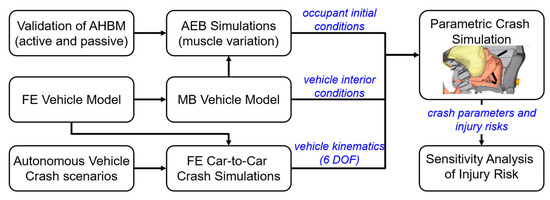
Figure 1.
Overview of sensitivity analysis of variables in occupant injury risk.
2.2. Active Human Body Model
A computationally efficient 50th percentile adult male MADYMO AHBM was chosen as the human surrogate to conduct a large-scale parametric simulation study. Biofidelity of the AHBM was validated against volunteer experiment results for head and torso kinematics during AEB activation (Table 1) [13,34,35]. The AEB activation simulation was performed using a mid-sized sedan MB vehicle model by applying a 1G deceleration pulse at the center of gravity of the vehicle model (Figure 2) according to the literature [35]. Optimal muscle parameters were adjusted to mimic the average responses of volunteers in terms of longitudinal excursions and forward rotation angles of the head and torso. Since volunteers of an experimental study demonstrated significant variations in their kinematics during AEB activation, simulating volunteers’ behavior using a single set of muscle parameters might not be representative. Therefore, the AHBM was further validated for two additional sets of muscle tensing levels—weak and strong conditions representing the upper and lower bounds of volunteers’ responses, respectively. Impact responses of the AHBM were evaluated at component levels using cadaveric test data from the literature to ensure biofidelic responses during crash simulations (Table 1). Contact characteristics of body regions and stiffness between body regions were adjusted from the stock MADYMO AHBM model to enhance its biofidelity beyond the default settings of the model. Lastly, the risk of injury was predicted using empirical injury risk functions according to the literature shown in Table 2.

Table 1.
Validation matrix for the MADYMO active human body model.
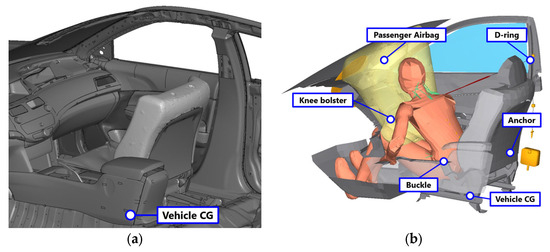
Figure 2.
A mid-sized sedan interior model for pre-crash and crash simulations. (a) LS-Dyna accord model and (b) MADYMO vehicle interior model.

Table 2.
Injury metrics for injury risk prediction.
2.3. Vehicle Models
Two types of vehicle models were used. First, the publicly available 2011 Honda Accord FE model was used for crash pulse generation during car-to-car crash simulations (Figure 2a) [59]. Interior and occupant restraint systems were converted into MADYMO environment to create an MB version of the vehicle model for occupant simulations. To improve computational efficiency, all parts except the airbag and seatbelt were modeled as rigid bodies using facet elements (Figure 2b). The MB vehicle model consisted of an instrument panel (IP), a right-side front door, a center console, a front-row passenger seat, a passenger airbag (PAB), and a 3-point seatbelt with a shoulder belt load limiter and a pre-tensioner. The MADYMO Accord vehicle model was validated through comparison with a real-world dummy crash test (NHTSA test number: MD5303). Responses of the small female H3 dummy model were compared with those from the crash test data (Figure 3). A generic passenger airbag model was used in the MADYMO simulation due to the unavailability of detailed information on the OEM airbag from the crash test. While the generic model did not reproduce the initial spike in head acceleration observed at around 35 ms in the test data, the simulation captured the overall trend well during the later phase. Overall, the MADYMO simulation results showed a good correlation with the test data. A comparison of injury metrics is provided in Supplementary Materials S1.
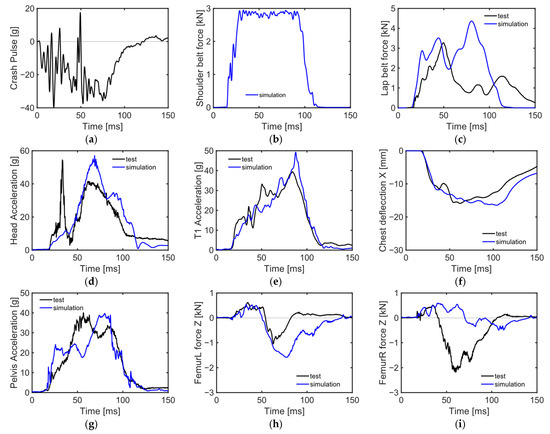
Figure 3.
Comparison of H3 small female dummy responses in physical test and MADYMO simulation under 56 km/h full frontal crash condition: (a) vehicle acceleration pulse, (b) shoulder belt load, (c) lap belt load over time, (d) resultant head acceleration, (e) resultant T1 acceleration, (f) chest deflection, (g) resultant pelvis acceleration, (h) left femur axial force, and (i) right femur axial force.
2.4. Parametric Simulation
2.4.1. Simulation Matrix
A parametric simulation study was conducted to investigate the effects of parameters relevant to autonomous vehicles on occupant injury risk. Parameters included occupant postures at the start of the crash simulation, seatback angles, seat track positions, seating locations, shoulder belt load limits, types of seat belt, and crash pulses (Table 3). Notably, only the BIS type belt was considered for the conceptual rear seat track position, which was 300 mm rearward from the baseline seat track position due to belt-fitting issues associated with the BPI seat belt. This simulation matrix resulted in a total of 12,096 crash simulations.

Table 3.
Variables of a parametric simulation study.
2.4.2. Occupant Posture at Crash
First, the AHBM was settled under gravity on the front right seat of the MADYMO vehicle model, which gave us the nominal occupant posture without AEB activation (Figure 4a,e). To obtain the initial posture of displaced occupants after AEB activation for crash simulations, AEB activation simulations were performed by varying the muscle activation strength in AHBM. The AEB simulation applied 0.8 G of longitudinal deceleration to the vehicle’s center of gravity (CG) based on the autonomous vehicle crash scenario (Figure 5) [60]. Using three levels of muscle tensing strengths (average, lower bound, and upper bound of volunteers behaviors), three additional occupant postures were obtained for each seatback angle (Figure 4b–d,f–h). Occupant postures and velocities were imported as initial conditions of the following crash simulations.
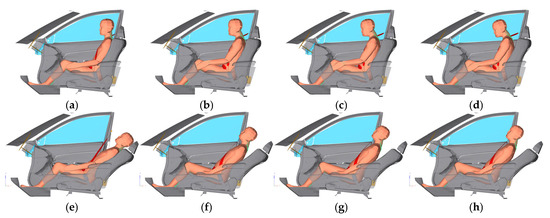
Figure 4.
Example of initial postures for an upright condition with baseline seat track position and B-pillar-integrated seat belt system at the beginning of the crash simulation. (a) Upright-nominal posture, (b) upright-strong bracing, (c) upright-normal bracing, (d) upright-weak bracing, (e) reclined-nominal posture, (f) reclined-strong bracing, (g) reclined-normal bracing, and (h) reclined-weak bracing.
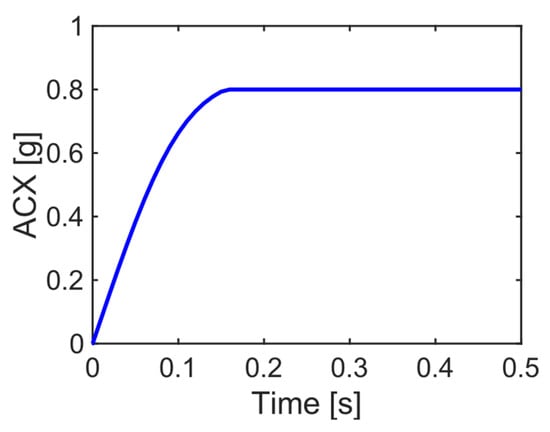
Figure 5.
Longitudinal acceleration for pre-crash automatic emergency braking (AEB) activation simulation.
2.4.3. Seat-Related Parameters
Two seatback angles were considered: upright (19°) and reclined (49°) (Figure 4). The seat track position for the 50th percentile adult male was selected as the baseline seat track position. Subsequently, forward and backward positions, each 50 mm from the baseline seat track position, were defined (Figure 6). Additionally, a position 300 mm rearward from the baseline seat track position was designated as a conceptual rear seat track position. In this conceptual rear condition, the occupant will have little interaction with the instrument panel or airbag.
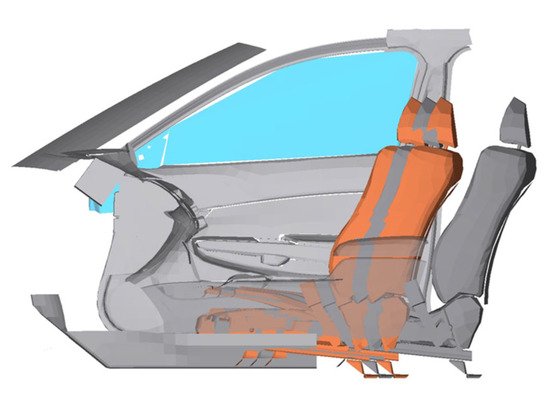
Figure 6.
Four-seat track locations. From left to right: −50 mm, baseline, +50 mm, and concept rear conditions (+300 mm).
2.4.4. Seatbelt Types and Load Limits
The BIS system was considered, along with a conventional B-pillar-integrated (BPI) seatbelt system (Figure 7). The BIS system was modeled based on the BPI seatbelt system, with the D-ring joint location relocated from the B-pillar to the upper part of the seat. For a reclined condition, the D-ring location of the BIS system was rotated along with the seatback to maintain a consistent distance between the hinge joint of the seat and the D-ring location. Two levels of the load-limiter were considered to obtain a general trend based on a parametric study [61].

Figure 7.
Types of shoulder belt attachment: (a) upright-BPI (B-pillar-integrated), (b) upright-BIS (belt-in-seat), (c) reclined-BPI, and (d) reclined-BIS.
2.4.5. Crash Pulses
Autonomous vehicle-relevant crash conditions from the literature were used as baseline crash conditions. In one study, 150 head-on accidents collected by a South Korean insurance company were reconstructed using PC-Crash software (DSD, Linz, Austria) [62]. Virtual AEB systems were then activated to observe changes in crash configurations and frequencies [60]. Based on these analyses, the two most common autonomous vehicle-relevant crash scenarios were selected, considering both their frequency and severity (Figure 8a). These configurations represented the most frequent scenarios involving a host vehicle equipped with automatic emergency braking (AEB). Among these, cases with some of the highest crash severities were selected to determine the initial crash conditions. For the 21KR0040 case, the relative velocity, heading angle, and overlap were 93.8 km/h, 209°, and 43%, respectively. For the 21KR0090 case, the relative velocity, heading angle, and overlap were 81.2 km/h, 215°, and 90%, respectively. Variations from baseline values were applied to these three parameters to generate crash pulses for parametric simulations (Figure 8b). This approach resulted in 27 variations of crash conditions for each scenario.
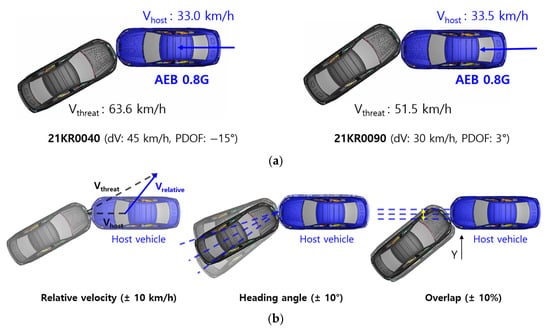
Figure 8.
Baseline crash conditions and application of variations. (a) Two autonomous vehicle relevant crash scenarios, and (b) method for applying variations to crash conditions.
For these selected scenarios, car-to-car crash simulations were conducted using a 2011 Honda Accord model in LS-Dyna (version R11.1.0, LSTC, Livermore, CA, USA) to generate crash pulses for occupant simulation with the MADYMO software. After crash simulations, crash severity (ΔV) and principal direction of forces (PDOF) were calculated (Equations (1) and (2)). The PDOF was computed at every moment during the crash. Its value at the point when ΔV reached its maximum was used for further analysis.
To account for occupants seated on both the driver side and the passenger side, 27 mirrored crash pulses reflected along the y-axis were included while keeping the AHBM in the passenger-side seat to simulate occupant responses in the driver-side seat under identical crash scenarios. It was assumed that the interior environment for the driver side was the same as that for the passenger side. This methodology resulted in a total of 54 crash pulses, with 27 allocated to each of the driver and passenger locations.
2.5. Crash Simulation Procedure
The vehicle’s initial velocity at the time of the crash (Figure 8) was applied to the center of gravity of the vehicle model (Figure 2b) using the INITIAL.JOINT_VEL keyword in the MADYMO software [63]. Subsequently, six-degree-of-freedom vehicle kinematics were prescribed to the center of gravity of the vehicle model, represented as linear and angular acceleration time histories obtained from the finite element (FE) car-to-car crash simulation.
For conditions without AEB activation, initial joint positions of the AHBM from the gravity settling simulation were used to position the AHBM for crash simulation (Figure 4a,e). All initial velocities of the AHBM joints, except for the joint between the AHBM and the reference frame, were set to zero. For the AEB activation simulation, the AHBM model’s joint positions and velocities at the end of the pre-crash AEB simulation were imported into the AHBM using the INITIAL.JOINT_POS and INITIAL.JOINT_VEL keywords, respectively (Figure 4b–d,f–h) [63]. While the initial relative joint positions could be imported using the Active Human Initializer tool in XMADgic, initial joint velocities needed to be defined manually [63]. The initial joint velocity of the AHBM was specified using an in-house code developed in the MATLAB R2022b environment (MathWorks, Natick, MA, USA) [64]. To prevent excessive muscle activation during crash simulation, muscle activation was disabled throughout the simulation process.
2.6. Sensitivity Analysis
Based on MADYMO crash analysis results, injury metrics, and injury risks for 10 body regions were calculated using injury risk functions available in the literature (Table 2). Effects of considered parameters, including occupant excursion during AEB activation, seatback angle, seat track position, and types of seat belts, were analyzed by comparing differences between average values of injury risk for each body region. The significance of differences in median injury metrics or injury risk values was evaluated using the Wilcoxon rank sum test [65]. A p-value of less than 0.05 from the statistical test indicated that the difference between the two groups was statistically significant. Each body region was analyzed independently to assess the sensitivity of the variable of interest. Since the analyses were not intended to test a global hypothesis across all body regions, adjustments for multiple comparisons were not applied.
3. Results
3.1. Biofidelity Evaluation of the AHBM
Figure 9 compares the responses of volunteers and the AHBM during AEB activation (Table 1). The normal muscle strength produced similar head kinematics and shoulder belt forces to those from volunteer test data. Scaling the muscle strength of the normal condition by 65% and 150% resulted in similar head and torso excursion amounts with upper and lower bounds of response corridors, respectively, in terms of magnitudes. However, a weak setting muscle strength resulted in greater head and torso rotation than the upper bounds of response corridors. Due to space limitations, the excursion data of the AHBM are provided in Supplementary Materials S2. Also, the impact responses of the AHBM generally followed the response corridors from the cadaveric tests (see Supplementary Materials S3).
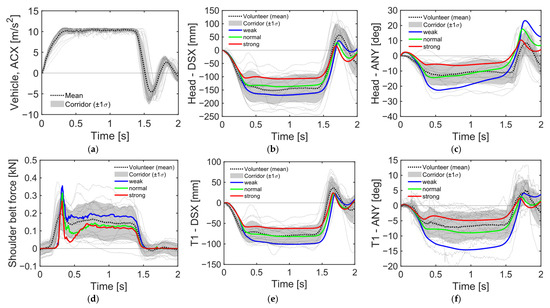
Figure 9.
Comparison of the kinematics of volunteers and the AHBM during 1G emergency braking across three muscle tension levels: (a) vehicle deceleration pulse, (b) longitudinal head excursion, (c) head rotation about the local Y-axis, (d) shoulder belt force over time, (e) longitudinal T1 excursion, and (f) T1 rotation about the local Y-axis.
3.2. Crash Pulse of an Autonomous Vehicle
Peak longitudinal accelerations of baseline conditions for 21KR0040 and 21KR0090 were 34G and 24G, respectively (Figure 8a, Figure 10a). Peak lateral accelerations for the two baseline conditions (21KR0040 and 21KR0090) were both around 10G (Figure 10b). Peak yaw rates for the two baseline conditions were 100 deg/s and 206 deg/s, respectively (Figure 10c). Distribution of the ΔV and PDOF of the 54 car-to-car crash simulations ranged from 25–55 km/h and from −26° to 27°, respectively (Figure 10e–10f, Figure 8b, Equations (1) and (2)).
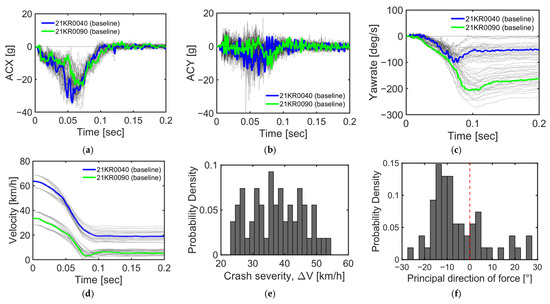
Figure 10.
Vehicle kinematics time histories and distributions of ΔV and principal direction of force from 54 car-to-car crash simulations: (a) vehicle acceleration along the local X-axis, (b) vehicle acceleration along the local Y-axis, (c) vehicle yaw rate over time about the local Z-axis, (d) vehicle velocity change over time, (e) distribution of velocity change (ΔV), and (f) distribution of principal direction of force.
3.3. Average Injury Risk from Parametric Simulations
A total of 12,096 crash simulations were performed, incorporating variations in factors such as pre-crash AEB activation-induced posture displacement and seatback angle. Of these, 340 simulations were prematurely terminated before reaching 150 milliseconds of analysis time. Consequently, these incomplete simulation cases were excluded from subsequent analyses. On average, the brain, cervical spine (c-spine), thorax, and lumbar spine (l-spine) exhibited the highest injury risks (Figure 11). Injury risks for the lower extremities were relatively lower than those for the upper body and the spine. Time histories of the AHBM behaviors from selected parametric simulations can be found in Supplementary Materials S4.
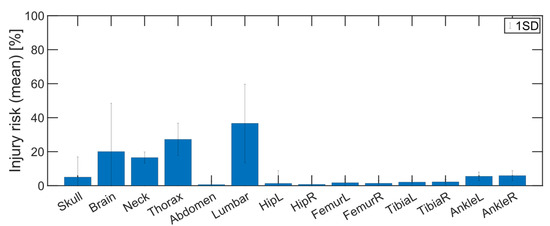
Figure 11.
Average injury risk for each body region from the complete simulation results.
3.4. Parameter Effects on Injury Risk
Effects of different variables considered in the parametric simulation on human injury risk were analyzed. In cases where the difference between the two groups was statistically significant based on the Wilcoxon rank sum test, an asterisk is placed on the x-axis label of the graph.
3.4.1. Effect of Seatback Angle
The effect of the seatback angle or seating posture on human injury was significant for all body regions, while the degree of sensitivity varied depending on body regions (p < 0.05). Compared to the upright posture, the reclined posture resulted in an increased average injury risk for the skull, brain, c-spine, and l-spine, while the injury risk for the thorax decreased. The most significant increase in average injury risk was observed for the brain, which showed a 15.4% increase in the reclined posture compared to the upright posture. The skull demonstrated the second-largest increase (8.2%) in injury risk associated with a reclined posture (Figure 12). A significant increase in l-spine injury risk was observed only under the no-AEB condition, whereas no such increase was noted with AEB.
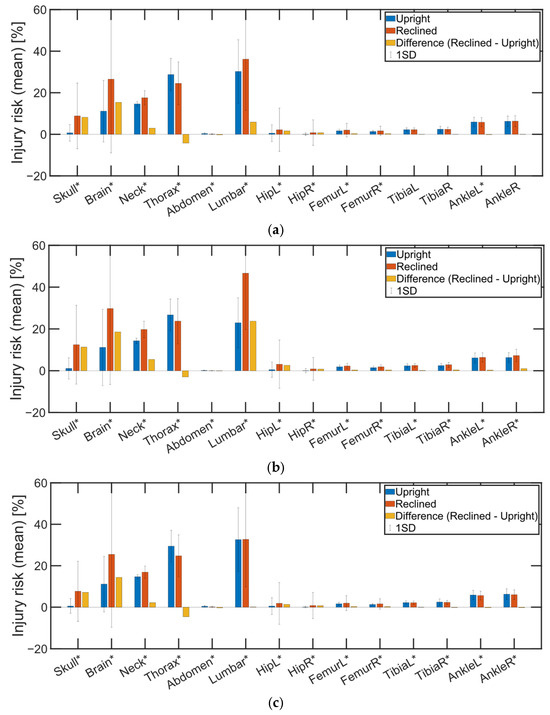
Figure 12.
Effects of reclined posture vs. upright posture on injury risk, excluding a concept rear seat track position: (a) AEB + No AEB, (b) no AEB, and (c) AEB. * Indicates a statistically significant difference between the two groups.
3.4.2. Effect of AEB Activation
The effect of out-of-position due to pre-crash AEB activation of 0.8G is shown in Figure 13. Among the initial forward excursions of the occupant’s head considered, the muscle weak condition showed the greatest excursion amount, followed by muscle normal and muscle strong conditions (Figure 4d,f). The initial excursion of the nominal posture without AEB activation was zero (Figure 4a,e). With initial occupant excursion due to AEB activation, injury risks of the skull, brain, c-spine, and l-spine regions decreased compared to those from nominal posture conditions. The risk of abdominal and right hip injuries slightly increased with AEB activation. When analyzing the effect of displaced posture separately for upright and reclined postures, the average injury risk difference in an upright posture ranged from −5.2% to 4.6% (Figure 13b). In contrast, in a reclined posture, the occupant excursion due to the activation of AEB reduced injury risks of the head, brain, c-spine, and l-spine by up to 11% (Figure 13c). These body regions coincided with those that showed an increased injury risk in a reclined condition compared to an upright condition (Figure 12).
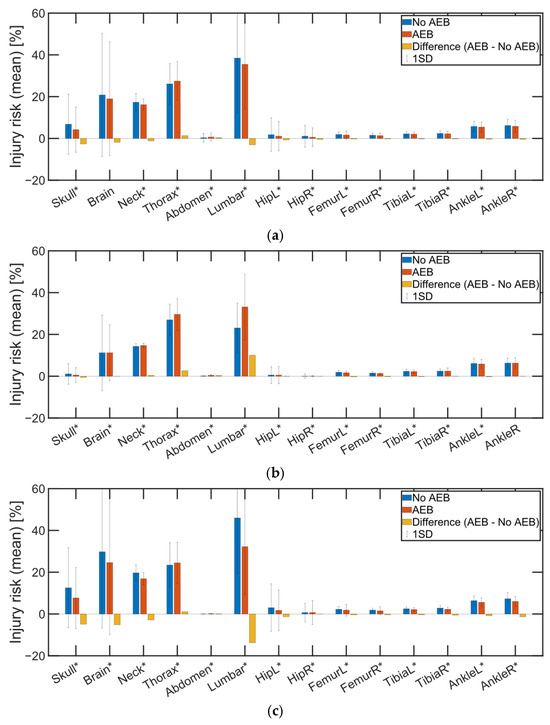
Figure 13.
Effect of AEB excluding seat track position for concept rear. (a) Both upright and reclined seatback conditions, (b) upright seatback condition, and (c) reclined seatback condition. * Indicates a statistically significant difference between the two groups.
3.4.3. Effect of Seat Track Position
In general, the risk of injuries varied slightly as the seat was moved forward by 50 mm. In contrast, the risk of l-spine injuries increased as the seat was moved rearward by 50 mm (Figure 14b). For the 300 mm rearward seat position, substantial increases in the average injury risk for the brain (13.1%) and l-spine (22.0%) were observed compared to the baseline seat track position (Figure 14c). However, the risk of chest injury showed no significant change with a concept rearward position compared to the baseline condition, possibly due to the presence of a shoulder belt load limiter. Note that only the BIS system was considered for the concept rearward position.
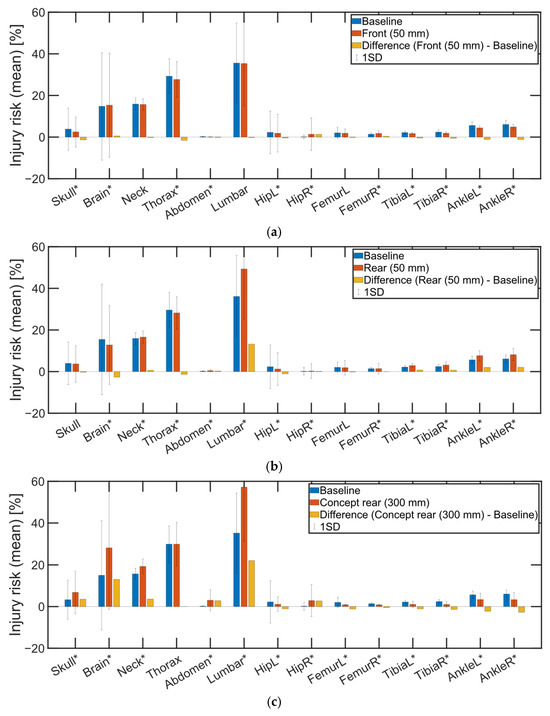
Figure 14.
Effect of seat track position (belt-in-seat): (a) front 50 mm, (b) rear 50 mm, and (c) concept rear 300 mm. * Indicates a statistically significant difference between the two groups.
3.4.4. Effects of Belt System Types
When comparing the effects of BPI and BIS on injury risk, the concept of rear seat track position was excluded because BPI seatbelt application was not practical for that position. While BIS increased the risk of l-spine injuries by 14.7%, it reduced the risk of brain injuries by 7.5% compared to those of the BPI (Figure 15). Both the increase in l-spine injury risk and the decrease in brain injury risk with BIS were more pronounced in a reclined posture than in an upright posture (Figure 15b,c). The risk of lower extremity injuries, which include the hip to ankle regions, was insensitive to seatbelt types.
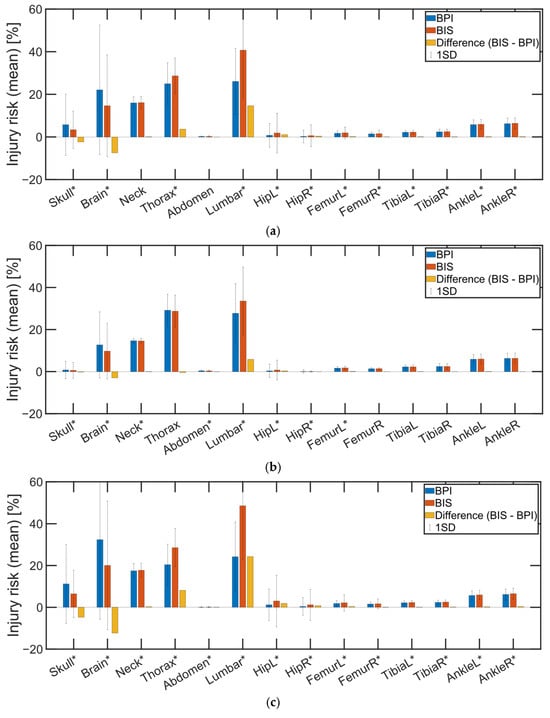
Figure 15.
Effect of belt-in-seat excluding the concept rear seat track position: (a) both upright and reclined seatback conditions, (b) upright seatback condition, and (c) reclined seatback condition. * Indicates a statistically significant difference between the two groups.
4. Discussion
4.1. Overview
The objective of this study was to compare the effects of autonomous vehicle occupant safety-relevant parameters—such as AEB activation, seatback angle, and seat track position—on occupant injury risk. This effort also aimed to help prioritize these parameters in autonomous vehicle crash safety evaluations. To enable broader conclusions, the study incorporated variations in vehicle crash conditions, levels of muscle activation during AEB events, seating locations, and seat belt types, which significantly increased the number of required simulations. To manage the resulting computational burden, a validated multi-body (MB) human body model was employed.
The findings of this study indicate that the seatback angle is one of the most influential parameters affecting the risk to head and neck regions, particularly for conventional seat track positions. Furthermore, when the seat track was moved to the concept rear position, a substantial increase in injury risk in the brain and l-spine regions was observed. In this study, the reclined seatback angle and the concept of rear seat track position were the most influential factors, as they deviated the most from the baseline seating posture and location. A detailed discussion of these findings is presented in the following sections.
4.2. Upright vs. Reclined Posture
Risks of injury to the skull, brain, c-spine, and l-spine were higher in the reclined posture than those in the upright posture. During the simulation, the shoulder belt was the only measure controlling head kinematics in a crash involving a reclined seatback. Additionally, due to the oblique nature of the representative crash condition identified for AEB-equipped vehicles, the head of the reclined occupant often missed the frontal airbag. The fixed location of the frontal airbag increased the distance between the occupant and the airbag in the reclined posture. This greater relative distance resulted in more uncontrolled head kinematics compared to the upright posture, leading to increased head rotation and elevated neck forces and moments. Previous epidemiological studies have shown similar trends [18]. While these studies considered both frontal and side-impact conditions, they reported odds ratios greater than one for injuries to the HFN (head, face, and neck) regions in a reclined posture. Dissanaike et al. (2008) have also demonstrated that as the seat is reclined, the mortality rate of front-seat occupants is increased [19].
The average chest injury risk based on chest anterior-posterior compression decreased slightly by 4.2% in a reclined posture compared to that in an upright posture. Similar findings have been reported in previous studies, although degrees of reduction are different. One study showed that the reduction in chest compression amount was as much as 0.8% and 16.5% with a reclined angle using GHBMC and THUMS models, respectively [66]. Furthermore, the effect of seatback reclination on the risk of MAIS3 or higher chest injuries was not statistically significant in a field data analysis [18].
The l-spine injury risk, which was based on axial compressive load, increased by 5.9% on average in a reclined posture compared to an upright posture. Previous studies have similarly reported an increase in lumbar compression force with increasing seatback angle [20,21,31]. Two studies have suggested that the axial force of the l-spine is increased by 37–44 N/° [20,21]. Another study has shown that l-spine compression is increased by around 35 N/° with an OEM seat model for the additional 20 degrees of rotation from the upright posture [31]. Interestingly, the increase of the l-spine injury risk under a reclined seatback angle was more pronounced without AEB activation, which showed a 23.7% increase, than that with AEB activation, which showed only a 0.1% increase. One hypothesis is that the activation of the AEB might have changed the reclined occupant’s posture closer to the upright posture, which could reduce the compressive loading to the l-spine. Lastly, the risk of lower extremities was insensitive to seatback angles.
4.3. Effect of Activation of AEB on Injury Risk
When evaluating the effect of an occupant’s forward excursion due to AEB activation on injury risk, it was found that the average risks for head, brain, and c-spine injuries decreased by up to 2.6% compared to those under a no-AEB activation condition (Figure 13a). These reductions were more pronounced in the reclined seatback condition, which showed up to a 5.1% reduction in injury risk for head and neck regions (Figure 13b).
In frontal crashes, the forward excursion of the occupant caused by AEB activation reduced the distance between the occupant and the frontal airbag. This reduction in distance might have improved the interaction between the head and the frontal airbag, leading to a decreased risk of head and neck injuries, particularly in the reclined condition. Another modeling study has also demonstrated that occupant excursion caused by pre-crash braking can influence the injury risk in frontal crash scenarios [28]. In this study, the head injury criterion (HIC) was reduced by 19%, although chest deflection was increased by 20%. Similarly, another study has reported a reduction in neck torsion under pre-impact braking conditions compared to no-braking conditions with an upright seatback [30].
Overall, the effect of occupant excursion due to the activation of AEB (0.8G for 0.5 s) was smaller than that caused by a 20-degree reclination of the seatback from its upright posture (Figure 12 and Figure 13a). The impact of AEB activation was primarily protective and more pronounced when the seatback was reclined instead of upright (Figure 13c). This protective effect from AEB activation raises an interesting question about pre-crash pretensioning devices [11,28]. While such systems may reduce occupant excursion during AEB activation, their effects on injury risk for reclined occupants warrant further investigation.
4.4. Effect of Seattrack Position
In general, risks of skull, c-spine, and thorax injuries changed very little when the seat was placed forward, while the risk of l-spine injuries increased for the 50 mm rearward seat track position (Figure 14). In a concept rear position (+300 mm), the average l-spine injury risk was further increased by 22% compared to that in the baseline position. One modeling study has investigated the effect of the distance between the knee bolster and the lumbar behavior under a simplified frontal impact condition [22] and found that early restraint to the knees using the knee bolster can reduce the flexion of the thoracolumbar junction (TLJ) by rotating the pelvis forward. This effect also lowered the axial force of the l-spine across various seatback angles ranging from 40 to 60 degrees. Other studies have also shown that removing knee bolsters can increase the risk of submarining and l-spine flexion moments [20,21,67]. The average risk of brain injuries increased by 13.1% in the concept rear condition compared to that in the baseline seat track position. This increase was attributed to the lack of interaction between the head and the passenger frontal airbag due to a greater distance between them.
4.5. BPI vs. BIS
The BIS system, on average, reduced the risk of head and c-spine injuries compared to the BPI system. However, it was associated with an increased risk of l-spine and thoracic injuries (Figure 15). This trend was particularly pronounced in the reclined posture (Figure 15c). In addition, this increase in l-spine injury risk appears to be influenced by the vertical component of the shoulder belt force in the BIS system, which arises due to a horizontal belt geometry around the shoulder relative to the thorax of the AHBM (Figure 7). A previous study has also suggested that the BIS system can reduce the forward motion of the occupant through earlier belt engagement compared to the BPI system, although this might lead to higher compressive forces on the l-spine [67].
4.6. Limitations
This study has several limitations. First, to conduct 12,096 simulations considering various variables and for applying the variations, the MADYMO AHBM was used instead of an FE human model. The MADYMO AHBM has been primarily validated for upright postures and component-level blunt impact conditions. Consequently, its biofidelity under reclined postures requires further validation. The interaction between the AHBM upper body and the seat belt in a reclined posture is particularly worthy of investigation. The risk of abdominal injuries was mostly insensitive to crash and restraint parameters. Thus, this model might require an improvement of its biofidelity around the abdominal and pelvic regions to be able to predict the submarining phenomenon. If the capability of the model in predicting submarining is improved, the pelvic forward excursion and abdominal compression amount would also increase with the occurrence of the submarining phenomenon during the frontal crashes [21]. The increased pelvic forward excursion would also increase the l-spine load due to the increase in the flexion of the l-spine. Although the biofidelity of the AHBM is limited, general trends in the sensitivity between crash and occupant parameters and the risk of injuries could still be observed.
Second, the study considered only a limited range of crash conditions, including occupant anthropometries, vehicle interiors, restraint systems, and crash scenarios. The findings are applicable only to frontal crashes, as the two reconstructed autonomous vehicle cases involved oblique frontal impacts. Furthermore, the results are based on typical restraint systems, including a three-point seatbelt with a pretensioner and load limiter, a frontal airbag, and a knee bolster. Additionally, the exclusion of toe pan intrusion effects may have masked the potential protective benefits of rearward seating for foot and ankle injuries.
Future research should explore a broader range of occupant anthropometries, pre-crash vehicle maneuvers (such as lateral avoidance), and varied vehicle interior and restraint system configurations.
5. Conclusions
In summary, consideration of a reclined seatback angle might take higher priority over occupant excursion caused by AEB activation when evaluating the crash safety of autonomous vehicles. However, occupant excursions could become more critical in scenarios involving either evasive steering maneuvers or different crash conditions where the coverage of an occupant protection system is limited.
Next to a reclined posture, the concept rear seat track position poses a challenge for protecting the brain and lumbar regions of occupants due to the lack of a restraint force to the knee and the interaction between the head and the conventional frontal airbag.
Lastly, the AEB activation demonstrated the protective effects of the reclined seatback angle by allowing forward rotation of the upper body prior to the crash. This result suggests that correcting an occupant’s initial posture at the crash is worthy of further investigation as an active safety concept, which has also been suggested by earlier studies [22,68].
Supplementary Materials
The following supporting information can be downloaded at: https://www.mdpi.com/article/10.3390/app15126492/s1, Table S1.1: comparison of injury metrics between an H3-05F physical dummy and an H3-05F MADYMO model; Figure S2.1: postures of the active human body model at the time of crash (t = 0) due to pre-crash emergency braking (seat track position: front, seat belt type: B-pillar-integrated; Table S2.1: excursions and body rotations of the active human body model compared to nominal posture due to pre-crash emergency braking (seat track position: front, Seat belt type: B-pillar-integrated); Figure S2.2: postures of the active human body model at the time of crash (t = 0) due to pre-crash emergency braking (seat track position: front, Seat belt type: belt-in-seat); Figure S2.2: postures of the active human body model at the time of crash (t = 0) due to pre-crash emergency braking (seat track position: front, seat belt type: belt-in-seat); Table S2.2: excursions and body rotations of the active human body model compared to nominal posture due to pre-crash emergency braking (seat track position: front, seat belt type: belt-in-seat); Figure S2.3: postures of the active human body model at the time of crash (t = 0) due to pre-crash emergency braking (seat track position: baseline, seat belt type: B-pillar-integrated); Table S2.3: excursions and body rotations of the active human body model compared to nominal posture due to pre-crash emergency braking (seat track position: baseline, seat belt type: B-pillar-integrated); Figure S2.4: postures of the active human body model at the time of crash (t = 0) due to pre-crash emergency braking (seat track position: baseline, seat belt type: belt-in-seat); Table S2.4: excursions and body rotations of the active human body model compared to nominal posture due to pre-crash emergency braking (seat track position: baseline, seat belt type: belt-in-seat); Figure S2.5: postures of the active human body model at the time of crash (t = 0) due to pre-crash emergency braking (seat track position: rear, seat belt type: B-pillar-integrated); Table S2.5: excursions and body rotations of the active human body model compared to nominal posture due to pre-crash emergency braking (seat track position: rear, seat belt type: B-pillar-integrated); Figure S2.6: postures of the active human body model at the time of crash (t = 0) due to pre-crash emergency braking (seat track position: rear, seat belt type: belt-in-seat); Table S2.6: excursions and body rotations of the active human body model compared to nominal posture due to pre-crash emergency braking (seat track position: rear, seat belt type: belt-in-seat); Figure S2.7: postures of the active human body model at the time of crash (t = 0) due to pre-crash emergency braking (seat track position: concept rear, seat belt type: belt-in-seat); Table S2.7: excursions and body rotations of the active human body model compared to nominal posture due to pre-crash emergency braking (seat track position: concept rear, seat belt type: belt-in-seat); Figure S3.1: head frontal impact (Melvin et al., 1989); Figure S3.2: head frontal drop (Loyd et al., 2012); Figure S3.3. frontal sled 15 g (Ewing et al., 1968, 1973); Figure S3.4: lateral sled 7 g (Klinich et al., 1995); Figure S3.5: (a), (b) thorax frontal cylindrical impact (Kroell et al., 1971; Kroell et al., 1974), (c) thorax frontal hammer impact (Bouquet et al., 1994); Figure S3.6: thorax frontal oblique cylindrical impact, 4.3 m/s (Yoganandan et al., 1997); Figure S3.7: thorax oblique pendulum impact (Viano et al., 1989); Figure S3.8: shoulder lateral pendulum impact (ISO9790); Figure S3.9: shoulder lateral cylindrical impact 1.0 m/s (Subit et al., 2010); Figure S3.10: shoulder lateral cylindrical impact 3.0 m/s (Subit et al., 2010); Figure S3.11: shoulder lateral cylindrical impact 1.5 m/s (Compigne et al., 2004); Figure S3.12: shoulder lateral cylindrical impact 3.0 m/s (Compigne et al., 2004); Figure S3.13: abdomen frontal bar impact 6.1 m/s (Cavanaugh et al., 1986); Figure S3.14: abdomen lateral oblique pendulum impact (Viano et al., 1989); Figure S3.15: pelvis lateral pendulum impact (Viano et al., 1989); Figure S4.1: time-history signal of MADYMO active human body model (crash pulse: 21KR0040/nominal posture without AEB activation/seat back angle: upright, reclined/seat track position: baseline/seating location: driver/seat belt type: belt-in-seat); Figure S4.2: time-history signal of MADYMO active human body model (crash pulse: 21KR0040/nominal posture without AEB activation/seat back angle: upright, reclined/seat track position: baseline/seating location: passenger/seat belt type: belt-in-seat); Figure S4.3: time-history signal of MADYMO active human body model (crash pulse: 21KR0040/normal bracing with AEB activation/seat track position: baseline/seating location: driver/seat belt type: belt-in-seat); Figure S4.4: time-history signal of MADYMO active human body model (crash pulse: 21KR0040/normal bracing with AEB activation/seat back angle: upright, reclined/seat track position: baseline/seating location: passenger/seat belt type: belt-in-seat). References [36,37,38,39,40,41,42,43,44,45,46,47,48,49] are cited in the Supplementary Materials.
Author Contributions
Conceptualization, T.K.; methodology, T.K.; software, S.S.; validation, S.S., T.K. and J.K.; formal analysis, S.S., T.K. and J.K.; investigation, S.S.; resources, T.K.; data curation, S.S.; writing—original draft preparation, S.S. and T.K.; writing—review and editing, T.K.; visualization, S.S. and J.K.; supervision, T.K.; project administration, T.K.; funding acquisition, T.K. All authors have read and agreed to the published version of the manuscript.
Funding
This research was supported by the Ministry of Trade, Industry and Energy (MOTIE) through the Korea Planning and Evaluation Institute of Industrial Technology (KEIT) as part of the Automotive Industry Technology Development (R&D)—Smart Car Project (RS-2024-00507638/2410005353). This work was also supported by the 2024 sabbatical year research grant of the Tech University of Korea.
Institutional Review Board Statement
Not applicable.
Informed Consent Statement
Not applicable.
Data Availability Statement
The original contributions presented in this study are included in the article. Further inquiries can be directed to the corresponding author.
Conflicts of Interest
The funders had no role in the design of this study, data collection, data analyses, data interpretation, writing of the manuscript, or the decision to publish the results.
References
- SAE International. Taxonomy and Definitions for Terms Related to On-Road Motor Vehicle Automated Driving Systems, J3016_202104; SAE International: Warrendale, PA, USA, 2021. [Google Scholar]
- Koopman, P.; Wagner, M. Autonomous vehicle safety: An interdisciplinary challenge. IEEE Intell. Transp. Syst. Mag. 2017, 9, 90–96. [Google Scholar] [CrossRef]
- National Highway Traffic Safety Administration (NHTSA). Critical Reasons for Crashes Investigated in the National Motor Vehicle Crash Causation Survey; Crash Stats Report No. DOT HS 812 115; NHTSA: Washington, DC, USA, 2015. Available online: https://crashstats.nhtsa.dot.gov/Api/Public/ViewPublication/812115 (accessed on 1 April 2025).
- Zhang, L.; Yuan, K.; Chu, H.; Huang, Y.; Ding, H.; Yuan, J.; Chen, H. Pedestrian collision risk assessment based on state estimation and motion prediction. IEEE Trans. Veh. Technol. 2021, 71, 98–111. [Google Scholar] [CrossRef]
- Chen, Y.; Li, S.; Tang, X.; Yang, K.; Cao, D.; Lin, X. Interaction-aware decision-making for autonomous vehicles. IEEE Trans. Transp. Electrific. 2023, 9, 4704–4715. [Google Scholar] [CrossRef]
- Lubbe, N.; Wisch, M.; Seiniger, P.; Johannsen, H.; Winner, H. Predicted road traffic fatalities in Germany: The potential and limitations of vehicle safety technologies from passive safety to highly automated driving. In Proceedings of the IRCOBI Conference, Athens, Greece, 12–14 September 2018. [Google Scholar]
- McCarthy, R.L. Autonomous vehicle accident data analysis: California OL 316 Reports: 2015–2020. ASCE-ASME J. Risk Uncertain. Eng. Syst. Part B Mech. Eng. 2022, 8, 034502. [Google Scholar] [CrossRef]
- Liu, Q.; Wang, X.; Wu, X.; Glaser, Y.; He, L. Crash comparison of autonomous and conventional vehicles using pre-crash scenario typology. Accid. Anal. Prev. 2021, 159, 106281. [Google Scholar] [CrossRef]
- Leledakis, A.; Östh, J.; Davidsson, J.; Jakobsson, L. The influence of car passengers’ sitting postures in intersection crashes. Accid. Anal. Prev. 2021, 157, 106170. [Google Scholar] [CrossRef]
- Leledakis, A.; Lindman, M.; Östh, J.; Wågström, L.; Davidsson, J.; Jakobsson, L. A Method for predicting crash configurations using counterfactual simulations and real-world data. Accid. Anal. Prev. 2021, 150, 105932. [Google Scholar] [CrossRef]
- Olafsdottir, J.M.; Brolin, K.; Halldin, P.; Östh, J.; Svensson, M.Y. Passenger kinematics and muscle responses in autonomous braking events with standard and reversible pre-tensioned restraints. In Proceedings of the IRCOBI Conference, Gothenburg, Sweden, 11–13 September 2013. No. IRC-13-70. [Google Scholar]
- Reed, M.P.; Ebert, S.M.; Hallman, J.J. Occupant Dynamics during Crash Avoidance Maneuvers; Report No. DOT HS 812 997; National Highway Traffic Safety Administration (NHTSA): Washington, DC, USA, 2021.
- Huber, P.; Marzougui, D.; Avdija, M. Passenger kinematics in braking, Lane change and oblique driving maneuvers. In Proceedings of the IRCOBI Conference, Lyon, France, 9–11 September 2015. [Google Scholar]
- Jorlöv, S.; Bohman, K.; Larsson, A. Seating positions and activities in highly automated cars—A qualitative study of future automated driving scenarios. In Proceedings of the IRCOBI Conference, Antwerp, Belgium, 13–15 September 2017. [Google Scholar]
- Koppel, S.; Charlton, J.; Fildes, B.; Stephens, A.; Fitzharris, M. Seating configuration and position preferences in fully automated vehicles. Traffic Inj. Prev. 2019, 20 (Suppl. S2), S103–S109. [Google Scholar] [CrossRef]
- Östling, M.; Larsson, A. Occupant activities and sitting positions in automated vehicles in China and Sweden. In Proceedings of the 26th International Technical Conference on the Enhanced Safety of Vehicles (ESV), Eindhoven, The Netherlands, 10–13 June 2019. [Google Scholar]
- Nie, B.; Gan, S.; Chen, W.; Zhou, Q. Seating preferences in highly automated vehicles and occupant safety awareness: A national survey of Chinese perceptions. Traffic Inj. Prev. 2020, 21, 247–253. [Google Scholar] [CrossRef]
- Schaefer, L.C.; Schaefer, L.C.; Junge, M.; Vörös, I.; Koçaslan, K.; Becker, U. Odds ratios for reclined seating positions in real-world crashes. Accid. Anal. Prev. 2021, 161, 106357. [Google Scholar] [CrossRef]
- Dissanaike, S.; Kaufman, R.; Mack, C.D.; Mock, C.; Bulger, E. The effect of reclined seats on mortality in motor vehicle collisions. J. Trauma Acute Care Surg. 2008, 64, 614–619. [Google Scholar] [CrossRef] [PubMed]
- Rawska, K.; Gepner, B.; Kulkarni, S.; Chastain, K.; Zhu, J.; Richardson, R.; Perez-Rapela, D.; Forman, J.; Kerrigan, J.R. Submarining sensitivity across varied anthropometry in an autonomous driving system environment. Traffic Inj. Prev. 2019, 20, S123–S127. [Google Scholar] [CrossRef] [PubMed]
- Rawska, K.; Gepner, B.; Moreau, D.; Kerrigan, J.R. Submarining sensitivity across varied seat configurations in autonomous driving system environment. Traffic Inj. Prev. 2020, 21, S1–S6. [Google Scholar] [CrossRef] [PubMed]
- Ji, P.; Huang, Y.; Zhou, Q. Mechanisms of using knee bolster to control kinematical motion of occupant in reclined posture for lowering injury risk. Int. J. Crashworthiness 2017, 22, 415–424. [Google Scholar] [CrossRef]
- Porkolab, L.; Lakatos, I. A Simulation system for testing side crashes, in non-traditional seating positions, for self-driving cars. Acta Polytech. Hungarica 2023, 20, 63–82. [Google Scholar] [CrossRef]
- Östh, J.; Larsson, E.; Jakobsson, L. Human body model muscle activation influence on crash response. In Proceedings of the IRCOBI Conference, Porto, Portugal, 14–16 September 2022. [Google Scholar]
- Global Human Body Models Consortium (GHBMC). User Manual: Simplified Pedestrians Versions 1.5.3, 1.6.3, 2.4.3 for LS-DYNA®; Elemance LLC: Durham, NC, USA, 2020. [Google Scholar]
- Kato, D.; Nakahira, Y.; Atsumi, N.; Iwamoto, M. Development of human-body model THUMS Version 6 containing muscle controllers and application to injury analysis in frontal collision after brake deceleration. In Proceedings of the IRCOBI Conference, Athens, Greece, 12–14 September 2018; pp. 207–223. [Google Scholar]
- Östh, J.; Pipkorn, B.; Forsberg, J.; Iraeus, J. Numerical reproducibility of human body model crash simulations. In Proceedings of the IRCOBI Conference, Online, 8–10 September 2021. [Google Scholar]
- Tran, T.D.; Hsiao, H.M.; Kuo, C.Y.; Chen, Y.C. Validation of MADYMO human body model in braking maneuver with highly reclined seatback. Int. J. Crashworthiness 2022, 27, 1743–1752. [Google Scholar] [CrossRef]
- Matsuda, T.; Takahashi, Y.; Kimpara, H.; Shibata, T.; Watanabe, I. Simulation of occupant posture changes due to evasive manoeuvres and injury predictions in vehicle frontal and side collisions. In Proceedings of the IRCOBI Conference, Athens, Greece, 12–14 September 2018. [Google Scholar]
- Antona, J.; Ejima, S.; Zama, Y. Influence of the driver conditions on the injury outcome in front impact collisions. Int. J. Automot. Eng. 2011, 2, 33–38. [Google Scholar] [CrossRef][Green Version]
- Forman, J.; Lin, H.; Gepner, B.; Wu, T. Occupant safety in automated vehicles-effect of seatback recline on occupant restraint. Int. J. Automot. Eng. 2019, 10, 139–143. [Google Scholar] [CrossRef]
- Boyle, K.J.; Reed, M.P.; Zaseck, L.W.; Hu, J. A human modelling study on occupant kinematics in highly reclined seats during frontal crashes. In Proceedings of the International Research Conference on the Biomechanics of Impact, IRCOBI, Florence, Italy, 11–13 September 2019. IRC-19-43. [Google Scholar]
- Meijer, R.; Rodarius, C.; Adamec, J.; van Nunen, E.; Van Rooij, L. A first step in computer modelling of the active human response in a far-side impact. Int. J. Crashworthiness 2008, 13, 643–652. [Google Scholar] [CrossRef]
- Kirschbichler, S.; Huber, P.; Prüggler, A.; Steidl, T.; Sinz, W.; Mayer, C.; DAddetta, G.A. Factors influencing occupant kinematics during braking and lane change maneuvers in a passenger vehicle. In Proceedings of the International IRCobi Conference on the Biomechanics of Impact, Berlin, Germany, 10–12 September 2014. [Google Scholar]
- Precooni & OM4IS Data. Available online: https://zenodo.org/records/5747370 (accessed on 6 June 2025).
- Melvin, J.; Shee, T. Facial injury assessment techniques. In Proceedings of the 12th ESV Conference, Göteborg, Sweden, 29 May–1 June 1989. [Google Scholar]
- Loyd, A.M.; Nightingale, R.W.; Song, Y.; Luck, J.F.; Cutcliffe, H.; Myers, B.S.; Bass, C.D. Impact properties of adult and ATD heads. In Proceedings of the IRCOBI Conference Proceedings, Dublin, Ireland, 12–14 September 2012; No. 507. pp. 552–564. [Google Scholar]
- Ewing, C.L.; Thomas, D.J.; Beeler, G.W.; Patrick, L.M.; Gillis, D.B. Dynamic response of the head and neck of the living human to—G x impact acceleration (No. 680792). In Proceedings of the 12th Stapp Car Crash Conference, Detroit, MI, USA, 1968. SAE Technical Paper. [Google Scholar]
- Ewing, C.L.; Thomas, D.J. Torque versus angular displacement response of human head to-Gx impact acceleration (No. 730976). In Proceedings of the 17th Stapp Car Crash Conference, Coronado, CA, USA, 17–19 November 1973. SAE Technical Paper. [Google Scholar]
- Klinich, K.; Beebe, M.; Pritz, H.; Haffner, M. Performance criteria for a biofidelic dummy neck. In Draft Report US Department of Transportation; National Highway Traffic Safety Administration, Vehicle Research and Test Center: East Liberty, OH, USA, 1992. [Google Scholar]
- Kroell, C.; Schneider, D.; Nahum, A. Impact tolerance and response of the human thorax. In Proceedings of the 15th Stapp Car Crash Conference, Coronado, CA, USA, 17–19 November 1971; pp. 84–134. [Google Scholar]
- Kroell, C.; Schneider, D.; Nahum, A. Impact tolerance and response of the human thorax II. In Proceedings of the 18th Stapp Car Crash Conference, Denver, CO, USA, 7–9 November 1974; pp. 383–457. [Google Scholar]
- Bouquet, R.; Ramet, M.; Bermond, F.; Cesari, D. Thoracic and pelvis human response to impact. In Proceedings of the 14th International Technical Conference on the Enhanced Safety of Vehicles, Toronto, ON, Canada, 23–26 May 1994; Volume 1, pp. 100–109. [Google Scholar]
- Yoganandan, N.; Pintar, F.A.; Kumaresan, S.; Haffiner, M.; Kuppa, S. Impact biomechanics of the human thorax-abdomen complex. Int. J. Crashworthiness 1997, 2, 219–228. [Google Scholar] [CrossRef]
- Viano, D.C.; Lau, I.V.; Asbury, C.; King, A.I.; Begeman, P. Biomechanics of the human chest, abdomen, and pelvis in lateral impact. Accid. Anal. Prev. 1989, 21, 553–574. [Google Scholar] [CrossRef] [PubMed]
- ISO TR 9790; Road Vehicles—Anthropomorphic Side Impact Dummy—Lateral Impact Response Requirements to Assess the Biofidelity of the Dummy. International Organization for Standardizatinon: Geneva, Switzerland, 1999.
- Subit, D.; Duprey, S.; Lau, S.; Guillemot, H.; Lessley, D.; Kent, R. Response of the human torso to lateral and oblique constant-velocity impacts. Ann. Adv. Automot. Med./Annu. Sci. Conf. 2010, 54, 27. [Google Scholar]
- Compigne, S.; Caire, Y.; Quesnel, T.; Verries, J.P. Non-injurious and injurious impact response of the human shoulder: Three-dimensional analysis of kinematics and determination of injury threshold (No. 2004-22-0005). In Proceedings of the 48th Stapp Car Crash Conference, Nashville, TN, USA, 1–3 November 2004. SAE Technical Paper. [Google Scholar]
- Cavanaugh, J.M.; Nyquist, G.W.; Goldberg, S.J.; King, A.I. Lower abdominal tolerance and response. SAE Trans. 1986, 611–633. [Google Scholar]
- Eppinger, R.; Kuppa, S.; Saul, R.; Sun, E. Supplement: Development of Improved Injury Criteria for the Assessment of Advanced Automotive Restraint Systems: II; National Highway Traffic Safety Administration (NHTSA): Washington, DC, USA, 2000.
- Gabler, L.F.; Crandall, J.R.; Panzer, M.B. Development of a second-order system for rapid estimation of maximum brain strain. Ann. Biomed. Eng. 2019, 47, 1971–1981. [Google Scholar] [CrossRef]
- Kent, R.; Patrie, J. Chest deflection tolerance to blunt anterior loading is sensitive to age but not load distribution. Forensic Sci. Int. 2005, 149, 121–128. [Google Scholar] [CrossRef]
- Craig, M.; Parent, D.; Lee, E.; Rudd, R.; Takhounts, E.; Hasija, V. Injury Criteria for the THOR 50th Male ATD; National Highway Traffic Safety Administration: Washington, DC, USA, 2020.
- Stemper, B.D.; Baisden, J.L.; Yoganandan, N.A.; Pintar, F.A.; DeRosia, J.; Whitley, P.; Shender, B.S. Effect of loading rate on injury patterns during high rate vertical acceleration. In Proceedings of the International Research Council on the Biomechanics of Injury Conference, Dublin, Ireland, 12–14 September 2012; Volume 40, pp. 217–224. [Google Scholar]
- Rupp, J.D.; Reed, M.P.; Miller, C.S.; Madura, N.H.; Klinich, K.D.; Kuppa, S.M.; Schneider, L.W. Development of new criteria for assessing the risk of knee-thigh-hip injury in frontal impacts using Hybrid III femur force measurements. In Proceedings of the 21st International Technical Conference on the Enhanced Safety of Vehicles, Stuttgart, Germany, 15–18 June 2009. Paper 09-0306. [Google Scholar]
- Rupp, J.D.; Flannagan, C.A.; Kuppa, S.M. Injury risk curves for the skeletal knee–thigh–hip complex for knee-impact loading. Accid. Anal. Prev. 2010, 42, 153–158. [Google Scholar] [CrossRef]
- Kuppa, S.; Wang, J.; Haffner, M.; Eppinger, R. Lower extremity injuries and associated injury criteria (No. 2001-06-0160). In Proceedings of the International Technical Conference on Enhanced Safety of Vehicles, Toronto, ON, Canada, 12–15 May 2001. SAE Technical Paper. [Google Scholar]
- Funk, J.R.; Srinivasan, S.C.; Crandall, J.R.; Khaewpong, N.; Eppinger, R.H.; Jaffredo, A.S.; Petit, P.Y. The effects of axial preload and dorsiflexion on the tolerance of the ankle/subtalar joint to dynamic inversion and eversion (No. 2002-22-0013). In Proceedings of the 46th Stapp Car Crash Conference, San Antonio, TX, USA, 11–13 November 2002. SAE Technical Paper. [Google Scholar]
- National Highway Traffic Safety Administration (NHTSA). Crash Simulation Vehicle Models. Available online: https://www.nhtsa.gov/crash-simulation-vehicle-models (accessed on 6 June 2025).
- Shin, Y.; Kim, M.Y.; Jeong, J. Analysis of intersection accident trend of autonomous emergency braking system vehicle based on actual accident. J. Auto-Veh. Safety Assoc. 2023, 15, 35–44. [Google Scholar]
- Hasija, V.; Ruparel, T.; Kelkar, R.; Craig, M.J.; Takhounts, E.G. Injury risk evaluation for mid-sized females using finite element human body models. In Proceedings of the IRCOBI Conference, Cambridge, UK, 13–15 September 2023. [Google Scholar]
- Park, Y.; Park, W.; Kim, S. An in-depth analysis of head-on collision accidents for frontal crash tests of automated driving vehicles. J. Auto-Veh. Safety Assoc. 2023, 15, 88–94. [Google Scholar]
- MADYMO Reference Manual Version 2022.1. Available online: https://plm.sw.siemens.com/en-US/simcenter/mechanical-simulation/madymo/ (accessed on 6 June 2025).
- The MathWorks Inc. MATLAB, Version: 9.13.0 (R2022b); The MathWorks Inc.: Natick, MA, USA, 2022; Available online: https://www.mathworks.com (accessed on 1 November 2023).
- Wilcoxon, F. Individual comparisons by ranking methods. Biom. Bull. 1945, 1, 80–83. [Google Scholar] [CrossRef]
- Reichert, R.; Kan, C.D.S. Effect of Reclined and Rotated Seating for Automated Driving Systems; SAE Technical Paper No. 2022-01-5048; SAE International: Warrendale, PA, USA, 2022. [Google Scholar]
- Gepner, B.; Rawska, K.; Richardson, R.; Kulkarni, S.; Chastain, K.; Zhu, J.; Kerrigan, J. Challenges for occupant safety in highly automated vehicles across various anthropometries. In Proceedings of the 26th International Technical Conference on the Enhanced Safety of Vehicles (ESV): Technology: Enabling a Safer Tomorrow, Eindhoven, The Netherlands, 10–13 June 2019; National Highway Traffic Safety Administration: Washington, DC, USA, 2019. No. 19-0335. [Google Scholar]
- Östh, J.; Bohman, K.; Jakobsson, L. Evaluation of kinematics and restraint interaction when repositioning a driver from a reclined to an upright position prior to frontal impact using active human body model simulations. In Proceedings of the IRCOBI Conference, Online, 8–10 September 2020. [Google Scholar]
Disclaimer/Publisher’s Note: The statements, opinions and data contained in all publications are solely those of the individual author(s) and contributor(s) and not of MDPI and/or the editor(s). MDPI and/or the editor(s) disclaim responsibility for any injury to people or property resulting from any ideas, methods, instructions or products referred to in the content. |
© 2025 by the authors. Licensee MDPI, Basel, Switzerland. This article is an open access article distributed under the terms and conditions of the Creative Commons Attribution (CC BY) license (https://creativecommons.org/licenses/by/4.0/).